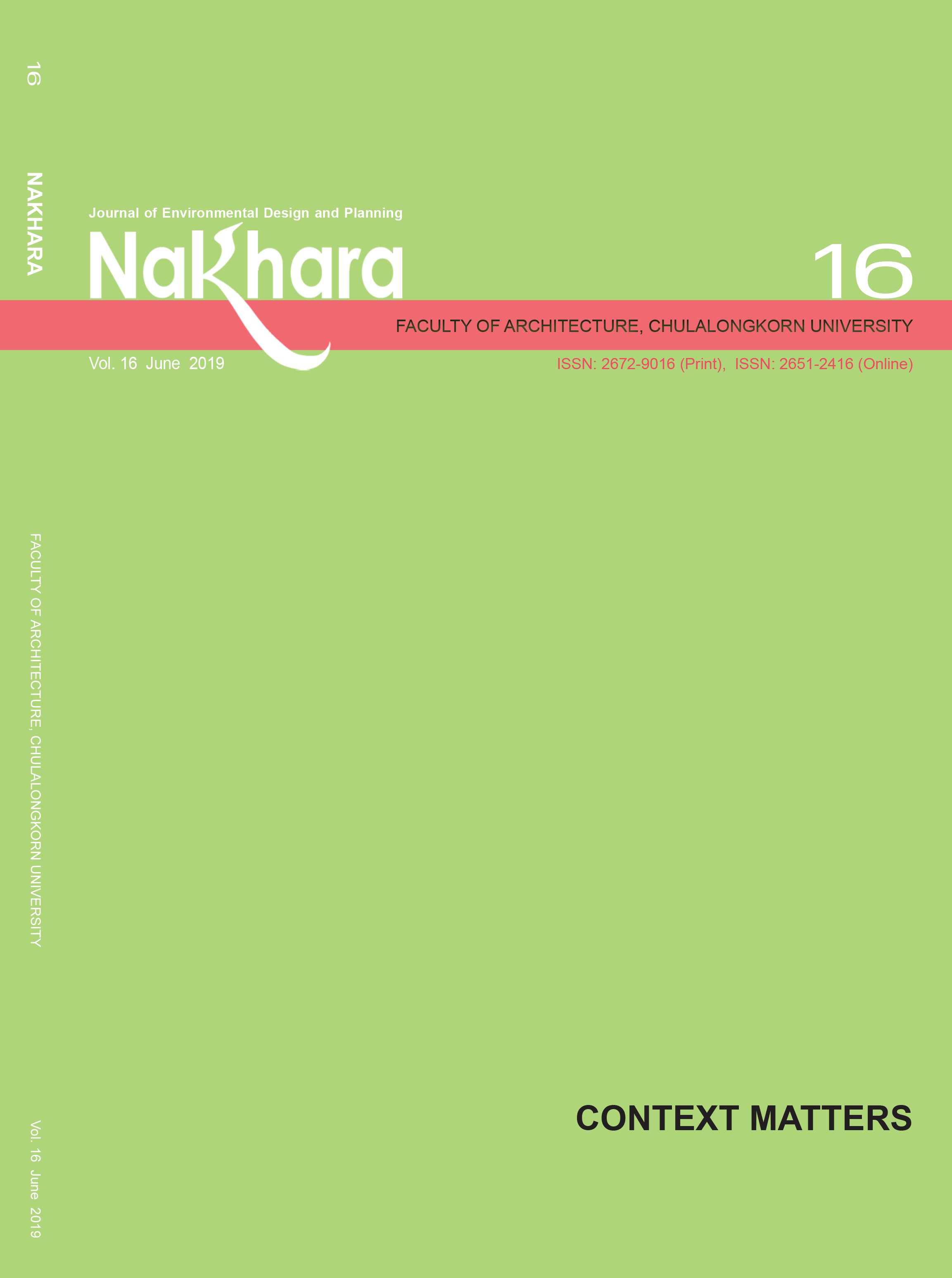Transformation of Cultural Landscape through Resilience Lens: A Case Study of Mae Kampong Village, Chiang Mai, Thailand
Main Article Content
Abstract
This study aims to understand the dynamics of the Mae Kampong’s cultural landscape through two intervening approaches. The study includes the cultural landscape and the community resilience. Both are examined to determine the transformations. An analysis was made of capital sources and management of resources. The methodology includes literary reviews, site observations, and interviews. The findings illustrate three periods; resilience, adaptation, and transformation. In the last phase, the community utilized their opportunities to transform into entrepreneurs. New activities emerged that included: rental houses, cafes, innovative mixed-use spaces and artisan-based shops located within the living museum sites. Sources of capital and management are varied due to their resources and their ability to obtain new knowledge and learning skills.
Article Details

This work is licensed under a Creative Commons Attribution-NonCommercial-NoDerivatives 4.0 International License.
References
in preservation. Preservation Education and Research, 1. Retrieve from https://ncpe.us/wp-content/uploads/2012/06/3ALLISONpaper.pdf
Fleming, J., & Ledogar, R. J. (2008). Resilience, an evolving concept: a review of literature relevant to Aboriginal research. Journal of Aboriginal and Indigenous Community Health, 6(2): 7-23.
Flight of the Gibbon. (2019). Our story. Retrieved from https://www.flightofthegibbon.com/en/about-us
Folke, C., Carpenter, S. R., Walker, B., Scheffer, M., Chapin, T., & J. Rockstrom. (2010). Resilience thinking:
integrating resilience, adaptability and transformability.
Ecology and Society, 15(4), 20. Retrieved from https://www.ccologyandsocicty.org/voll5!iss4/art20/
Found & Berbes-Blazquez. (2012). The sugar-cane landscape of the Caribbean Islands: Resilience, adaptation
and transformation of the plantation social—ecological system. In T. Plieninger & C. Bieling (Eds.), Resilience
and the Cultural Landscape: Understanding and Managing Change in Human-Shaped Environments (pp.164-
184). Cambridge University Press.
Harada, K. (2016). The village in transition: development and cultural, economic, and social changes in Mae Kampong Village, Chiang Mai, Thailand. In Proceedings from International Conference on Science, Technology, Humanities and Business Management. Bangkok.
Harada, K. (2018). The village in transition: development and cultural, economic, and social changes in Mae Kampong Village, Chiang Mai, Thailand. Chiang Mai: Chiang Mai University Press.
Lewis, P. (1979). Axioms for reading the landscape. Retrieved from: https://mrso.pbworks.com/f/Peirce%2520Lewis_Axioms.pdf
Nasser, N. (2003). Cultural Continuity and Meaning of Place: Sustaining Historic Cities of the Islamicate World. Journal of Architectural Conservation, 9(1), 74-89, DOI:10.1080/13556207.2003.10785336
Nelson. D. R., Adger, W. N., & Brown, K. (2007). Adaptation to environmental change: contributions of a resilience framework. Annual Review of Environment and Resources, 32, 395-419. Retrieve from https://doi.org/10.1146/annurev.
energy.32.051807.090348
Panin. O. (2007). Conservation of the Built Vernacular Heritage. Najua. 22.
Plieninger, T. & Bieling, C. (2012). Connecting cultural landscapes to resilience. In T. Plieninger & C. Bieling Eds),
5HVLOLHQFHDQGWKHFXOWXUDOODQGVFDSHXQGHUVWDQGLQJDQGPDQDJLQJFKDQJHLQKXPDQVKDSHGHQYLURQPHQWV. 49–64. Cambridge: Cambridge University Press.
Puangmara, P. (2003). 5XSEDHS.DQ&KDWNDQ/DHQJ7KRQJWKLDR&KRHQJ$QXUDN%DHS
Mae Kham Pong, Mae on, Chiang Mai Province]. Bangkok: Thailand Research Fund
Relph, E. (1986). Place and placelessness. Great Britain: Page Bros (Norwich) Limited.
Rotarangi, S. J., J. Stephenson. (2014). Resilience pivots: stability and identity in a social-ecological-cultural system. Ecology and Society (1): 28. Retrieved from https://dx.doi.org/10.5751/ES-06262-190128
Sauer, C O. (1925). The morphology of landscape. Berkeley, C$: University of California press.
Taylor, K. (2012). Landscape and meaning. In K. Taylor J. Lennon (Eds), Managing Fultural Oandscapes (pp.1-17).
Oxfordshire: Routledge.
UNESCO. (2009). World Heritage Paper 26. Cultural Oandscapes, D Kandbook for Fonservation and Panagement. Paris: UNESCO World Heritage Centre.
United States Agency for International Development (USAID). (2013). Community Uesilience: onceptual Iramework and Peasurement Ieed the Iuture learning agenda. Rockville, MD: Westat.
Wilson, G. A. (2012). Community resilience and environmental transitions. Oxon: Abingdon.
Yan W., Galloway W. (2017) Understanding Fhange Whrough the Oens of Uesilience. In: :Yan :Galloway ((ds) 5HWKLQNLQJUHVLOLHQFHDGDSWDWLRQDQGWUDQVIRUPDWLRQLQDWLPHRIFKDQJH. Retrieved from https://doi.org/10.1007/978-3-319-50171-0_1
Yang, C. Y. (2014). Cultural Uesilience in Asia: D Fomparative Vtudy of Keritage Fonservation in Lijiang and Bagan. (Doctoral dissertation). University of Washington, Washington, USA. Retrieved from https://digital.lib. washington.edu/researchworks/handle/1773/26240

